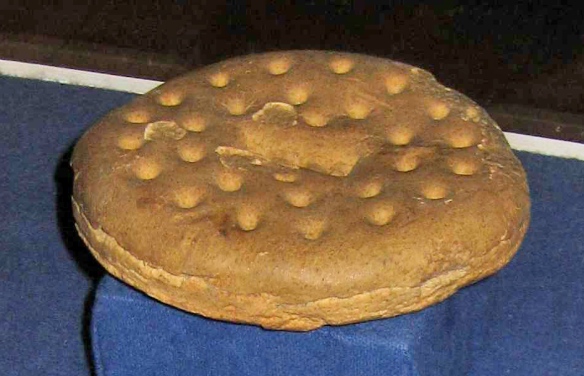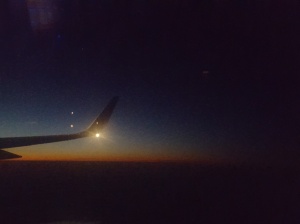
OLDEST SHIP BISCUIT. This specimen appears at the Maritime Museum in Kronborg Castle, Elsinore, Denmark. The biscuit dates from 1852. Image: Paul A. Cziko (https://en.wikipedia.org/wiki/Hardtack#/media/File:Oldest_ship_biscuit_Kronborg_DK_cropped.jpg)
It has been an interesting journey doing the research on sea biscuits and I am sure there is more information I haven’t found doing a quick internet search. Sea biscuits are the Navy’s equivalent of hardtack, which is a relatively new comer as it was named by the 19th Century American army. Given the simple recipe (mix flour and salt with water to make a dough, roll out into patties, bake in a medium oven for 30 min at least twice) these biscuits were probably around in prehistoric times and still surviving in some hidden cave somewhere. These biscuits last longer than flour as they have a lower moisture content and water activity. One disadvantage is that sea biscuits will absorb moisture if the humidity increases. This was a problem when Royal Navy ships first traveled in the tropics.
When I travel, even on short journeys, I am in the habit of carrying some food and water with me. Travel delays on trains and planes have been part of my travel experience and I prefer to know I have food rather than hope I can buy something if necessary. Travelers need food that has a long shelf-life, is robust, safe to eat, and calorie/nutrient dense. Many travelers’ food is dried as removing the moisture extends the shelf life by essentially making the food inedible to bacteria. While removing water has the advantage of stopping bacterial growth, it doesn’t always give us a food that is robust and could stand up to the rigors of travel. There have been a number of times I have reached into my rucksack for a cookie/biscuit and found crumbs. Not the snack I was hoping for!
The sea biscuit has more in common with Terry Pratchett’s Dwarf’s rock cakes than any modern cookie or cracker. So robust that, typically sea biscuits need to soaked overnight or smashed with a hammer or rock to able to eat it. Sea biscuits are the original cracker that was crumbled into New England chowder, probably because that was the only way the biscuits could be eaten. The British navy used to bake/dry their biscuits 4 times. So if you think biscotti are hard to eat without dunking, double the force needed to bite into a sea biscuit and book that trip to a dentist to replace your teeth. They were so hard that apparently an American civil war soldier wrote a letter on the side of a hardtack and mailed it with the address on the other side and it survived in the mail without any protection. No wonder British soldiers were envious of American food rations in World War 2.
In the process of making sea biscuits you knead the flour and water together. This allows for gluten formation and most of the recipes have a 2:1 ratio of flour to water which is perfect for gluten formation. Gluten is the protein that gives bread its springy texture and the network of gluten stays in place once heating is complete which means that bread keeps its structure after baking. While soft bread goes stale very quickly due to the retrogradation of starch, the starch in hardtack is probably all retrograded before leaving the oven. An interesting question would be to find out how much starch granules hydrate and swell in making of sea biscuits. Is enough for the starch molecules to gelatinize? Perhaps the water is removed too quickly for gelation and retrogradation occurs very quickly with little rearrangement of the starch molecules. (Confused – see my post on starch here!)
If you want to make your own sea biscuits there are lots of recipes online due to reenactors and survivalists wanting a food that is traditional and/or last a long time. They are also popular in Hawai’i and Alaska. Personally I would prefer water biscuits or Scottish oatcakes carefully wrapped than a food that is hard to eat. Trail mix would be more desirable still. However, if a zombie apocalypse is ever threatened, I know what I could bake to help my long term survival.
References
All references visited on 29 January 2018
- https://en.wikipedia.org/wiki/Hardtack background
- https://www.wikihow.com/Make-Hardtack recipes
- http://www.survivalnewsonline.com/index.php/2012/02/hardtack-a-great-survival-food-stock/ recipe
- http://cookit.e2bn.org/historycookbook/904-hardtack-ships-biscuits.html recipe
- http://www.gone-ta-pott.com/hard_tack_sea_biscuits.html recipe and history
- https://youtu.be/FyjcJUGuFVg video, history and recipe
- https://reclaimingtheloaf.wordpress.com/2012/03/01/biscuits/ history
- http://www.foodtimeline.org/foodcookies.html#shipsbiscuit and http://www.foodtimeline.org/foodcookies.html#hardtack history
- http://www.menshealth-questions.net/royalnavalmuseum.org/info_sheet_ship_biscuit.htm history
- http://militaryhistorynow.com/2014/07/11/hard-to-swallow-a-brief-history-of-hardtack-and-ships-biscuit-2/ history
- https://www.rmg.co.uk/discover/explore/ships-biscuit history
- http://www.janeausten.co.uk/ships-biscuit/ history

